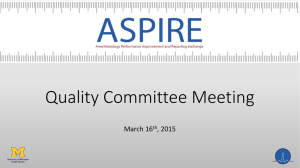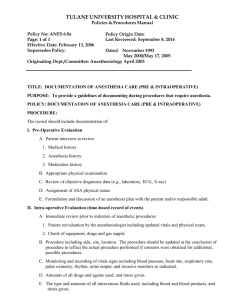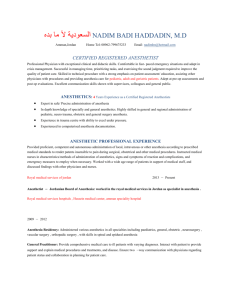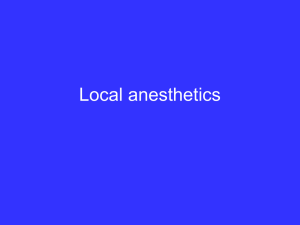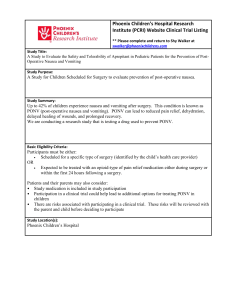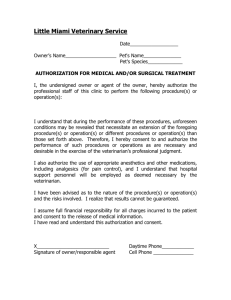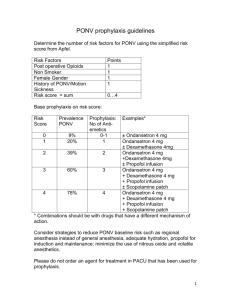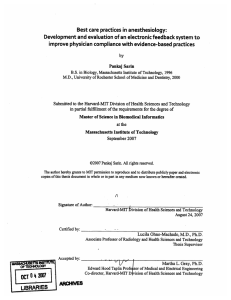Meeting Minutes - Anesthesiology Performance Improvement and
advertisement
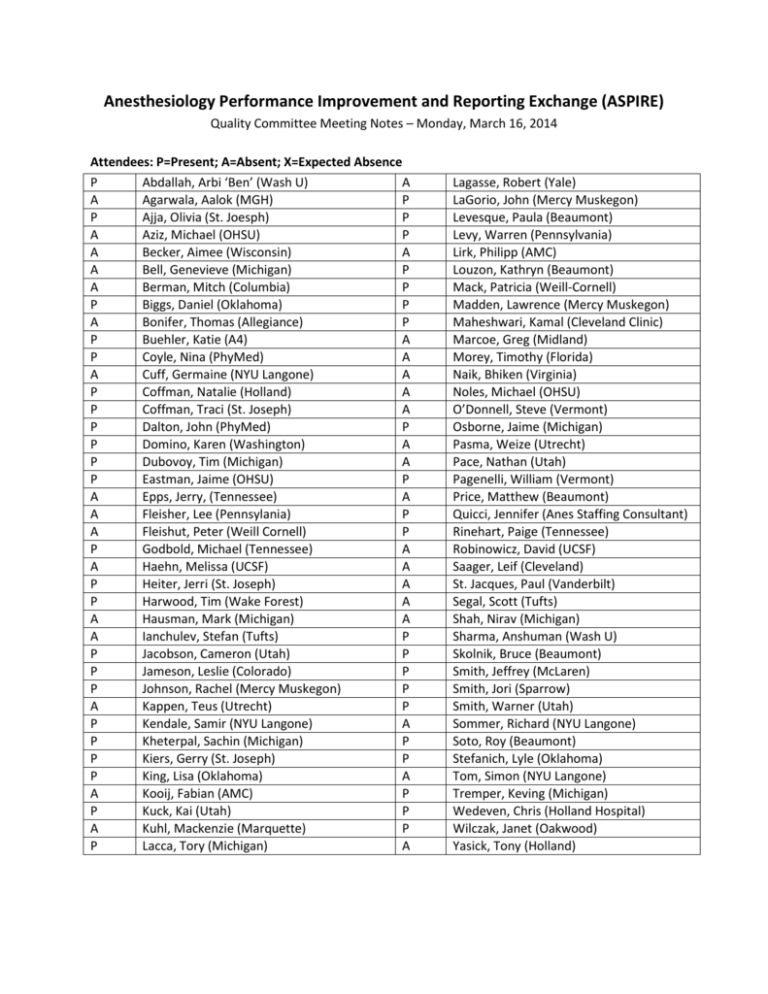
Anesthesiology Performance Improvement and Reporting Exchange (ASPIRE) Quality Committee Meeting Notes – Monday, March 16, 2014 Attendees: P=Present; A=Absent; X=Expected Absence P Abdallah, Arbi ‘Ben’ (Wash U) A A Agarwala, Aalok (MGH) P P Ajja, Olivia (St. Joesph) P A Aziz, Michael (OHSU) P A Becker, Aimee (Wisconsin) A A Bell, Genevieve (Michigan) P A Berman, Mitch (Columbia) P P Biggs, Daniel (Oklahoma) P A Bonifer, Thomas (Allegiance) P P Buehler, Katie (A4) A P Coyle, Nina (PhyMed) A A Cuff, Germaine (NYU Langone) A P Coffman, Natalie (Holland) A P Coffman, Traci (St. Joseph) A P Dalton, John (PhyMed) P P Domino, Karen (Washington) A P Dubovoy, Tim (Michigan) A P Eastman, Jaime (OHSU) P A Epps, Jerry, (Tennessee) A A Fleisher, Lee (Pennsylania) P A Fleishut, Peter (Weill Cornell) P P Godbold, Michael (Tennessee) A A Haehn, Melissa (UCSF) A P Heiter, Jerri (St. Joseph) A P Harwood, Tim (Wake Forest) A A Hausman, Mark (Michigan) A A Ianchulev, Stefan (Tufts) P P Jacobson, Cameron (Utah) P P Jameson, Leslie (Colorado) P P Johnson, Rachel (Mercy Muskegon) P A Kappen, Teus (Utrecht) P P Kendale, Samir (NYU Langone) A P Kheterpal, Sachin (Michigan) P P Kiers, Gerry (St. Joseph) P P King, Lisa (Oklahoma) A A Kooij, Fabian (AMC) P P Kuck, Kai (Utah) P A Kuhl, Mackenzie (Marquette) P P Lacca, Tory (Michigan) A Lagasse, Robert (Yale) LaGorio, John (Mercy Muskegon) Levesque, Paula (Beaumont) Levy, Warren (Pennsylvania) Lirk, Philipp (AMC) Louzon, Kathryn (Beaumont) Mack, Patricia (Weill-Cornell) Madden, Lawrence (Mercy Muskegon) Maheshwari, Kamal (Cleveland Clinic) Marcoe, Greg (Midland) Morey, Timothy (Florida) Naik, Bhiken (Virginia) Noles, Michael (OHSU) O’Donnell, Steve (Vermont) Osborne, Jaime (Michigan) Pasma, Weize (Utrecht) Pace, Nathan (Utah) Pagenelli, William (Vermont) Price, Matthew (Beaumont) Quicci, Jennifer (Anes Staffing Consultant) Rinehart, Paige (Tennessee) Robinowicz, David (UCSF) Saager, Leif (Cleveland) St. Jacques, Paul (Vanderbilt) Segal, Scott (Tufts) Shah, Nirav (Michigan) Sharma, Anshuman (Wash U) Skolnik, Bruce (Beaumont) Smith, Jeffrey (McLaren) Smith, Jori (Sparrow) Smith, Warner (Utah) Sommer, Richard (NYU Langone) Soto, Roy (Beaumont) Stefanich, Lyle (Oklahoma) Tom, Simon (NYU Langone) Tremper, Keving (Michigan) Wedeven, Chris (Holland Hospital) Wilczak, Janet (Oakwood) Yasick, Tony (Holland) Review dashboards: How many hospitals are in the process of getting data and what are the timelines? o All 10 Active MPOG institutions are able to get their data o BCBSM funded sites, none are actively contributing data and we are anticipating first upload in June 2015 First six measures we decided as a group are available to those contributing data There are 16 additional measures for year two that were chosen for QCDR participation, we as a group can make changes to those measures or add measure that we feel are necessary Measure updates: We want to be careful to not give feedback on measures that we do not have high quality data from the institution EMR o It is important to get CPT data Measure being put on hold: o INF 01: CPT data is required to create appropriate exclusions o GLU 01b and GLU 02b: We divided glucose into group ‘a’ and ‘b’ and the ‘b’ will be on hold until we can get better preop and PACU data o NMB 02: Discussion whether it makes sense to continue the original 4 hour time frame or should we change it to 3 hours? University of Colorado chairman is a pharmacologist and he ran the numbers and determined that 4 hours was the best time Four hours is the time frame we will use for this measure o PUL 01: Using the median tidal volume, instead of looking at 20 minute periods where tidal volume is greater than 10 ml/kg. The responsible provider will be the one who is in the case the majority of the time University of Colorado made everyone signed into the case as responsible providers to increase accountability. Year 2 measures: We started with 22 original measures before we decided on the final 6 for Year 1, we will need to review the remaining 16 measures and start to make decisions and get feedback to help create a work plan at the coordinating center for developing new reports. The following are the 16 measures: 1. Active warming for all patients at risk of intraoperative hypothermia 2. Core temperature measurement for all general anesthetics 3. At-risk adults undergoing general anesthesia given 2 or more classes of anti-emetics 4. At-risk pediatric patients undergoing general anesthesia given 2 or more classes of antiemetics 5. Colloid use limited in cases with no indication 6. Hemoglobin or hematocrit measurement for patients receiving discretionary intraoperative red blood cell transfusions 7. Transfusion goal of hematocrit less than 30 8. Appropriate intraoperative handoff 9. Appropriate postoperative transition of care handoff performed 10. Avoiding intraoperative hypotension 11. Avoiding gaps in systolic or mean arterial pressure measurement 12. Avoiding myocardial Injury 13. Avoiding kidney injury 14. Preventing uncontrolled post-operative pain 15. Mortality 16. Avoiding medication overdose We want to determine whether they should be included, what are the exclusion/inclusion criteria, etc. Perioperative normothermia: Active warming for all patients at risk of intraoperative hypothermia o Patients undergoing general and neuraxial anesthetics o Cases less than 60 minutes – anesthesia start to end o Documentation of active warming devices for patients (convection warmer) Any reason to change what we are looking at now? Is this for adults? It does not have to be adults. Feedback: If you look at short cases you have the most risk of waking up cold and so it may be better to look at longer duration cases. Should we remove the time frame completely? We want to meet the measure and the shorter cases may be more difficult. Once you put a patient to sleep the thermostats are changed in the room. Is there a normothermia measure that is looking at temperature? Yes, that is the next measure Perioperative normothermia: Core temperature measurement for all general anesthetics o Patients undergoing general anesthesia o Cases less than 30 minutes We see a lot of variation at the University of Michigan Does include PA temperature? It can and the rates are getting lower (cardiac and transplant) You will have to define the core temperature Any thoughts? We can come up with a core temperature for the measurement o This information could end up on physician compare. Any measure you report on for QCDR can end up on physician compare and they don’t plan on asking our opinion on whether the measure should be published for the public. PONV (adult): At-risk adults undergoing general anesthesia given 2 or more classes of antiemetics. o Inclusion: Patients undergoing general anesthetics o Exclusion: Non-general anesthetics, general anesthetic without use of inhalational anesthetic, fewer than 3 risk factors for PONV (female gender, non-smoker, PONV/motion sickness history, opiate administration) Recommend to include people on TIVA, do not limit to inhalational agent Would you count the propofol infusion as one treatment? High risk patient is one who got a TIVA Propofol should count as an anti-emetic treatment We will post this on the ASPIRE Forum to get more active discussion on how to create/define this measure PONV (Peds): Patients administered 2 or more classes of anti-emetics. o Patients undergoing general anesthetics o Non-general anesthetics, general anesthetic without use of inhalation anesthetic, fewer than 2 risk factors for PONV (surgery ≥ 30 minutes, age ≥ 3 years, strabismus surgery, history of POV or PONV in parent or sibling) o Risk factors for pediatrics are the same Complex problem to balance pain management and PONV and both measures should be looked at as a single or in combination. Is it still worth measuring that antiemetics were administered? It is worth measuring, but we should look at postoperative pain management also. We will stratify this measure over tonsillectomy patients. Why did you use fewer than 2 risk factors for PONV? It was based on a pediatric paper. Current practice that anyone over the age of three that has one risk factor gets two anti-emetics Colloid use limited in cases with no indication: Colloid use limited for patients that likely do not need colloid (Patients with mild to moderate blood loss, outpatient surgery, short to medium length prone surgery, all but the longest surgeries in other positions) o All patients undergoing procedures o Patients with >=4 units of intraoperative PRBC transfused; EBL >= 2000 ML; Prone surgery > 4 hours anesthesia time; Any surgery > 8 hours anesthesia time o This was a lower rated measure on the original survey we sent out when we were determining Year 1 measures. The reason we want to bring this back is that the data shows that avoiding colloid doesn’t change anything but the cost of anesthesia and it can be reported easily. Feedback: Colloids improve tissue oxygenation, and a lot of protocols require patients to be on colloids with a crystalloid infusion. There is an interest in using colloids in enhanced recovery programs. Feedback: Preoperative hematocrit needs to be documented. Some of the measure you want to score 100% and be perfect and we should look to meet a certain threshold, because we may find a level that reduces cost and shows that we are choosing wisely. Feedback: Are liver transplant are excluded? Can you choose the type of procedure and standardize to the procedure? Feedback: All the other measures have been targeting improving safety and outcomes and if this is targeting costs, then recommend moving this down the list. There is no evidence of safety for the patient. o This may be neutral in quality and if this proves that this reduces costs, then there is some use putting in a measure to reduce costs. o You might want to exclude other factors, such as specialty surgeries From a visualization perspective we are interested in seeing changes in trends over time. Defining Measures Part of the role of this group is to do the research and to define how we determine the measures. We can have measures without thresholds and then determine what the best way is. We need to have conversations in our specialty to help define the measures and what measures will be helpful. Blue Cross Blue Shield is willing to give us their cost data on the patient level, we have to be willing to do something with that data if they give it to us. Getting the postop data is important. Because we are just starting out and are a small group, now is a good time to find ways to have sites to submit their postop data, CPT codes and ICD-9 codes.
